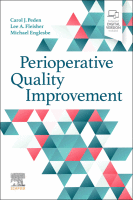Physical Address
304 North Cardinal St.
Dorchester Center, MA 02124

Key Points Perioperative care provides opportunities for the reduction of low-value testing and treatment, in line with evidence-based guidelines. Quality improvement (QI) projects focused on perioperative care can have a significant impact on patient outcomes and health system performance. There…

Key Points Perioperative opioid-sparing protocols for children are feasible. Standardized anesthesia protocols and accessible real-world data displayed as statistical process control charts can inform rapid PDSA (Plan-Do-Study-Act) cycles. Challenges to improvement work can be overcome using technology, data, communication, education,…

Key Points The Perioperative Quality Improvement Programme (PQIP) is a multidisciplinary initiative to evaluate the quality of care and outcomes of patients undergoing surgery in the UK National Health Service (NHS). PQIP enrolls patients undergoing major noncardiac surgery and measures…

Key Points Emergency laparotomy is a common high morbidity and high mortality procedure. Significant efforts have been made within the UK to improve the care of patients needing an emergency laparotomy. The EPOCH (Enhanced Perioperative Care for High-Risk Surgical Patients)…

Key Points Perioperative neurocognitive disorders represent a major public health issue. The Perioperative Brain Health Initiative (PBHI) aims to improve brain health in surgical patients through systematic improvements in awareness and clinical practice. Preliminary evidence suggests that implementation of perioperative…

Key Points The origin of health services research is discussed. Quantitative tools, including cross-sectional, cohort, case-control, and difference-in-difference study designs, are briefly reviewed. Qualitative tools, such as focus groups, surveys, and interviews, are covered. Examples of study designs in perioperative…

Key Points Overprescribing of opioids and new persistent opioid use after surgery are common problems. Granular data involving patient-reported outcomes and clinical behaviors are critical to inform pain care pathways. A remarkable number of stakeholders are involved in pain management…

Key Points Enhanced Recovery After Surgery (ERAS) is a series of evidence-based protocols that improve outcomes after surgery by optimizing patients before surgery, reduce stress and injury during surgery, and promote rapid return of preoperative function. ERAS pathways can be…

Key Points A significant proportion of unplanned healthcare encounters after stone surgery (ureteroscopy) are avoidable. Improvement in patient education decreases the rate of postoperative emergency department visits after ureteroscopy. Nonopioid pain pathways in appropriate patients are safe and feasible without…

Key Points Anesthesiology Performance Improvement and Reporting Exchange (ASPIRE), the quality improvement (QI) arm of the Multicenter Perioperative Outcomes Group (MPOG) and part of the family of Blue Cross Blue Shield Michigan (BCBSM) Collaborative Quality Initiatives (CQIs), works to overcome…